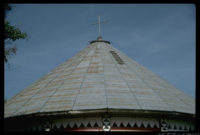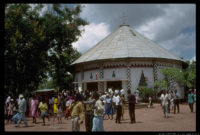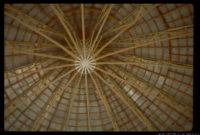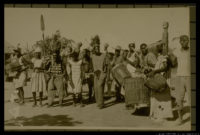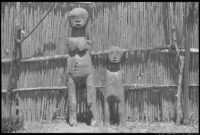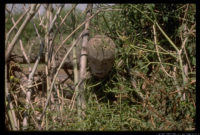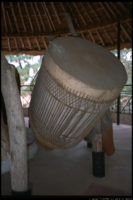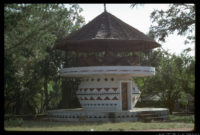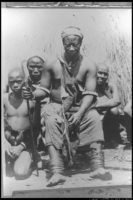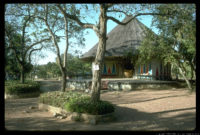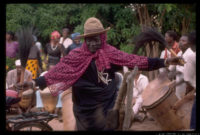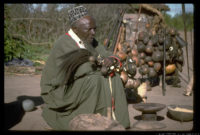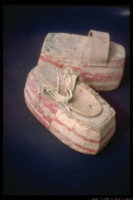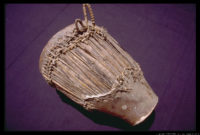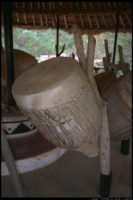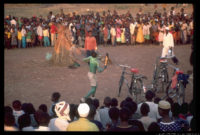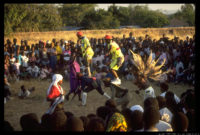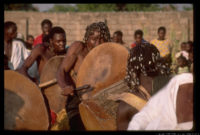by Mark H.C.Bessire
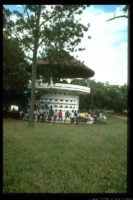
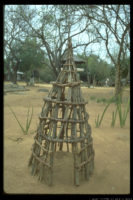
The Sukuma Museum in northwestern Tanzania has recently undertaken the task of recataloging its collection of objects from the Sukuma culture and is redesigning its exhibition spaces. Such a vigorous task has unearthed many issues regarding contemporary museum display and the contextualization of cultural artifacts in the museum setting. In reorganizing the twenty to thirty year old display, the Museum has had the opportunity to reconsider the significance of the objects and the efficacy of their educational value. The issues that were raised during the project were of topical and philosophical interest to museums of art and cultural artifacts. The Museum wanted to maintain the cultural heritage and ritual power of the objects and was concerned to avoid the silencing of such objects which were removed from practice and context when placed in the Museum. There was also an awareness of the relationship of the Museum collection to the history of the institution and the taxonomies that were utilized to organize the collection.[1] All of these considerations were related by the need to gain a better understanding of the permanent collection by reconciling its history, context, and identity with the museum setting. This working theme of history, context, and identity led the registration team to propose the building of a new exhibition hall that would illustrate, through archival photographs, films and text, the unique history of the Sukuma Museum and its permanent collection.
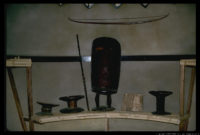
In past years the issue of the contextualization of cultural artifacts has been a topic of discussion for museums, artists, academia and cultural groups.[2] This discourse has often exposed the tendency of museums to defend a specific curatorial agenda through exhibition constructions or the decontextualization of an object or culture. The challenging of traditional cataloging and taxonomic paradigms has revealed the consequences of the curatorial manipulation of objects and their meaning. These issues influenced the Sukuma Museum’s initial project evaluation of its exhibition display. The Sukuma Museum has decided that the alternative to the museum dilemma of decontextualization is to display cultural objects in an educational setting providing all relevant cultural, aesthetic, and historical information while at the same time recognizing the inherent existence of the curatorial voice.[3] This creates a museum agenda that on one level strives to educate the public of the objects’ original contexts and meanings and on another level, recognizes the objects’ changing identities created by the decontextualization or layering of contexts within the museum setting.
Museum Setting and Changing Contexts
Museum exhibitions have helped to paved the way for such new tactics of museum display. Historically, for example, few shows have received as much critical attention as the 1984 Museum of Modern Art exhibition, Primitivism in 20th Century Art, Affinity of the Tribal and the Modern, in New York which today is seen as an important watershed of museological discourse. The exhibition and the critical response it evoked has proven pivotal in the slow process of influencing taxonomies of museum display and illuminating the intellectual cost of cultural imperialism.[4] In The Predicament of Culture (1988) James Clifford questioned the “collecting and authenticating practices in contemporary settings” and cited the example of the controversy surrounding the Museum of Modern Art over the relations between “tribal” and “modern” art.[5] Issues elicited by the MoMA exhibition revolved around the manipulation of African objects to justify a modernist reading of the influence of “tribal” art on early modernist artists. While providing educational material on the western art, MoMA provided minimal information on the African works which appeared to play only a subjunctive, chronological and aesthetic role. This over aestheticization and decontextualization of the African objects negated their own history, context and identity.[6]
The Sukuma Museum’s project has benefitted from the questions raised by the controversial dialogue surrounding context and the museum setting. Looking beyond the criticism that has revealed the injustices of cultural imperialism, there is much to be learned from analyzing the placement of non-western objects out of context and to face the inevitability that even “ethnographic contextualizations are [as] problematic as aesthetic ones, as susceptible to purified, ahistorical treatment.”[7] After analyzing the criticism of an exhibition like the Museum of Modern Art’s “Primitivism,” one can learn as much about the museum – it’s curators, director, patrons and culture – by the way it displays another culture as one can about the culture presented. This critical process of deconstructing curatorial and museum practices has influenced the Sukuma Museum’s decision to exhibit its own history to complement the impact of the permanent collection and enrich the object’s identities.
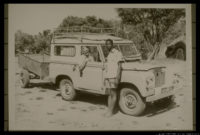
By activating the criticism and putting theory to practice the Sukuma Museum is in not only redesigning its exhibition of Sukuma culture, but reexamining the history of the institution itself. It is a process that will attempt to reveal the agenda of those in control of the display and the reasons why and how they chose to present certain aspects of Sukuma culture. This tactic is intended to demystify the authority of the Museum and place the institution’s history and mission on display as a historical document, an artifact itself, alongside the art collected and chosen to represent the culture. This is not a simple proposition for the Museum, which was originally founded by Father David Clement, a Catholic Missionary of Africa, with the help of two indigenous church groups, the Bana Sesilia and the Bujora Research Committee.[8] Today, one question that faces the Museum in its current soul searching revitalization, is how it should define its identity and context: ethnographically, historically, culturally, or as a living museum? Who is exhibiting whose culture? Though it is administered by the indigenous culture, it was founded by a progressive, if not radical, Canadian missionary and evolved slowly, certainly not linearly and owes a spiritual and financial debt to an innovative western institution, the Dartington Hall Trust of England.[9]
History of the Sukuma Museum
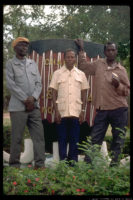
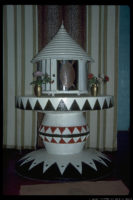
Yet up until now what has been presented at the Sukuma Museum does not reveal the full history of the Museum’s origins. Visitors view the excellent cultural art/artifacts of the collection and are exposed to information concerning the Sukuma chiefs, dance societies, blacksmiths, and traditional doctors. But, on another level, the Museum represents the history of the Catholic church in Africa and specifically the Sukuma region in Tanzania. The church at Bujora is situated at the end of a tree lined avenue where it dominates the surrounding Museum’s exhibition halls. The large circular church dominates the landscape and its painted patterns symbolically represent the triangular shape of a traditional Sukuma hoe. The triangular shape also resembles the lupingu, a Sukuma amulet worn in reverence for one’s maternal ancestors which the Bujora Church translated into a signifier for the Trinity of the Father, the Son, and the Holy Ghost. When the round church, the first of its type in Tanzania, was built in the 1950s in the shape of a Sukuma traditional home, it created quite a controversy.
In 1954, under Father David Clement, the Bujora Parish became the official experimental and spiritual center for adaptation in Tanzania. At that time adaptation, which was related to the teaching of the Catholic liturgy through indigenous symbols and traditions, was questioned by many western missionaries and African priests.[10] Even with detractors Clement was assisted by the regional Bishop, Bishop Blomjous of Holland, to form the Bana Sesilia and the Bujora Research Committee. Father Clement was able to channel local knowledge and faith to translate the Catholic liturgy and symbols into Kisukuma and later Kiswahili. Never part of a vision or a plan, the notion of a museum evolved from his work with adaptation. It was an excellent opportunity, in a particular era, at a specific site. The Museum later matured into a vehicle for adaptation and became an outlet for the work of the Bana Sesilia and Research Committee. It was also a time of transition for the Catholic Church in Tanzania, the Post-Independence government and a moment that Father Clement realized he could tap into. In the mid 1960s, soon after the government had abolished the power of the Sukuma chiefs, Clement emerged as a collector. He gained the faith of some royal families who were interested in preserving their royal objects and willing to give or trade them to Clement and the new museum or makumbusho in Kiswahili.[11]
Slowly objects were collected and placed in the Royal Pavilion, a structure built in the shape of a royal throne. Yet, even before the Royal Pavilion was built in 1969, the first Museum building, the Sukuma Homestead was dedicated to the Bana Sesilia and opened on November 22nd, 1968, the Feast day of St. Cecilia. The Homestead is a collection of Sukuma cultural artifacts donated by the Bana Sesilia. In 1971 the Bagalu and Bagika Dance Pavilion was built to illustrate the importance of dance for Sukuma culture and to pay homage to the region’s most important dance societies the Bagalu and Bagika. From as early as the 1950 Father Clement had attempted to incorporate Sukuma songs and dance into the church. He also realized the importance of gaining the respect of Sukuma dance leaders. It was possible that Clement thought that if he could influence or convert the powerful and influential dance leaders to Christianity maybe others would follow.[12] To this ends he also sponsored a dance festival that was inaugurated after the traditional Corpus Christi Feast day procession. Clement was the first leader to bring these two groups together for meetings and encouraged them to participate in dance competitions at Bulabo, the Sukuma name for the Feast of Corpus Christi.[13]
This brief history and description reveals how the history of the Museum complements the objects on display. It also forces a much richer understanding of this unique Museum’s place within Tanzania, Sukuma, and Catholic history. And if we return to the notion of constructing a curatorial agenda, one that chooses a single point of view, we can see how easy it would be for the Museum to disguise aspects of its identity by alienating the Catholic influences in order to recode the collection as a strictly Sukuma undertaking. When we examine the Sukuma Museum’s history as well as its exhibition agenda it is necessary to recognize the western role in its founding. For the African museum it is a challenge to define the philosophical heritage of categories and taxonomic systems. As V.Y. Mudimbe’s has suggested that,
Western interpreters, as well as African analysts, have been using categories and conceptual systems that depend on a Western epistemological order. Even in the most explicitly “Afrocentric” descriptions, models of analysis explicitly or implicitly, knowingly or unknowingly, refer to the same order.[14]
Reclaiming History
The current project of the Sukuma Museum is partially an attempt to define its categories and conceptual systems, which can be defined as taxonomies, and their relationship to history, context, and identity. The Museum wants to reclaim its history and to activate the collection to signify a reversal of perspectives. A large aspect of this break is a response to the western notion of what Mudimbe coins the idea of Africa, one that is framed by Eurocentric taxonomies, modes of display, and a linear perspective on civilizations and art history.[15] When these issues, which are equated to the museum agenda, are foregrounded limitations are placed on the museum’s institutional authority. Some museums in the United States have already been criticized for forcing certain readings of an artist or movement through particular exhibitions in an attempt to validate their institutional collecting. There may even be some criticism of early collecting at the Sukuma Museum, but the Museum feels responsible to unveil its history, context, and identity, allowing others to decide for themselves.[16]
Just as the American art historian Craig Owens commented on the postmodern shift from nature to culture and from history to discourse, art and ethnographical museums are transforming outdated taxonomies and are attempting to at least decode outmoded designations and labels.[17] In museums today, exhibition planning depends as much on how to display art as what art to display. The Sukuma Museum plans to go well beyond the basic museological criteria set forth below by Mudimbe and to decode the permanent collection by providing full documentation in Kisukuma, Kiswahili, and English. It will also eventually reveal the agenda of the Museum through an exhibition of the Museum’s history.
1) The first, the sociolocultural milieu, would identify the worked objects according to their procedures: were or are they made by gatherers, fishermen, cattle herders, agriculturalists?
2) The second, the criterion of social relations of production, may within the same culture separate or allow a complementary analysis of palace art and that of say, blacksmiths, healers, hunters, members of secret societies, women, etc.
3) The third, the criterion of function, could classify these objects according to their use: divination, funerary, entertainment, everyday life, religious, magic, etc.[18]
In addressing Mudimbe’s description of this decoding process the 1995/1996 Sukuma Museum registration project has met his three minimal criteria. The projects’ staff also agrees with Mudimbe that “such a three-pronged approach would account for the objects in the context of their own real background and transcend the shortcomings of anthropologists’ ethnologization and aestheticization of the objects.”[19] In many ways this recoding of the collection begins the leveling of the labeling field and prepares the way for the Sukuma Museum staff to then fully deal with the relation of object and order. Once the objects have been defined within their own history, context and identity, a new “ordering” may emerge.
Museum Display
The Sukuma Museum has also benefitted from analyzing recent museum exhibitions which have laid exemplary groundwork for comprehensive exhibitions of cultural artifacts. In 1993 The British Museum of Mankind presented the exhibition Paradise, Portraying the New Guinea Highlands. It was a progressive response to museological criticism of the past few years which unleashed, through practice and theory, the potential power of the presentation of traditional cultures in a contemporary light. Michael O’Hanlon, the curator, offered the viewer a museum setting that presented a society that has reconciled their traditional culture with contemporary popular culture. The exhibition illuminated how this reconciliation has invigorated the society and enabled it to defend itself against western acts of salvage or a nonhistorical placement in time. The exhibition was also an opportunity for the British Museum to collect objects for its permanent collection. This collection policy could adversely effect the indigenous culture and may have placed the museum in an awkward position of having to defend its collecting practices against potential criticism of cultural imperialism. Yet, the exhibition catalog not only provided traditional exhibition essays, but revealed every aspect of the curatorial process from its nascence to the placement of the collected objects in the permanent collection. The author provides a short history of the problems that such exhibitions as Paradise have been unable to come to terms with, and a step by step narrative of how he actually organized the purchasing of the objects and the effects this project had on the New Guinea Highland community. One may disagree with the purchasing of some of the objects, but one cannot fault the curator for his honesty in unveiling his own personal trepidations and the Museum’s decision making process. Through this self-reflexive, deconstructive curatorial process which is fully documented in the catalog, the show has been able to transcend the typical ahistorical, decontextualized, museumified exhibitions of “other” cultures that we often see in the ethnographic and art museums of Europe and America.
In another pivotal exhibition, The Center for African Art in New York presented the show Art/Artifact in 1988 which made the museum display of art the focus of an exhibition. It was an attempt to reveal how display can affect a viewer’s museum experience and contact with objects from another culture. The Center provided examples of how African art has been displayed since its arrival in western private collections and institutions. These included the curios cabinet, the commercial gallery, ethnographic museum, and modern art museum. This concrete, physical presentation exposed the crucial role of display, the amount of power that lays in the hands of the presenter, and how presentation or ordering influences the viewer’s relationship to the exhibited object. In its focus on the history of displays, the exhibition also highlighted the different taxonomic agendas, such as the search for natural history/evolution, culture collecting by imperialists, and “high” art.
The history of museum display and the exhibitions cited above revealed to the Sukuma Museum the importance of defining the history, context and identity of cultural artifacts as well as the agenda of the museum displaying such objects. The Museum of Mankind filled this criteria and presented an excellent visual and academic experience with their show “Paradise.” On the other hand the recent exhibition of African Art sponsored by the Royal Academy of London demonstrates how the issue of exhibiting African Art or “other” cultures in western museums is still far being resolved. The curatorial agenda of this exhibition was to produce a blockbuster show based on geography which emphasized the aesthetic diversity of African art. It offered viewers an aesthetic experience in the hopes of positing the objects as genuine works of “high” art “equal in aesthetic quality to Western artwork[s],” without providing information concerning their history, context, and identity.[20] It is long overdue for African art to enter western museums of “high” art, but the objects should not be forced to function or to assimilate to the aesthetic values of the west. All African objects are created for use in contexts such as ritual and religious, royal and domestic. Western museums should acknowledge the importance of the taxonomic shift from exhibitions in ethnological museums to “high” art museums and take a critical look at the consequences of shifting value systems. Professor Roy Sieber commented on the lack of educational background of the Royal Academy exhibition by suggesting that “Tom [Phillips] is undoing fifty years of art studies by claiming, like Roger Fry, ‘Don’t give me facts, just let me look at the object.”[21]
Dr. Paul Msemwa, Director of the Village Museum in Dar es Salaam, Tanzania, feels that contextualization is necessary when displaying African objects in a museum setting. He explained in an interview that objects should be accompanied by a cultural description, a photograph of the object (or of a similar type) in situ, and if possible video.[22] “The totality of the performance is art” and he continued by saying it can be difficult “to single out an object and say this is an art piece. I don’t know if in african communities if you have that culture of taking an object and just placing it there for the beauty of looking at it.”[23] The answer to display and taxonomic issues for the Village Museum, which Dr. Msemwa defines as a living museum is, to have cultural days supported by the local communities that present dance, song, cooking and other activities of their specific cultural group. He posits that his African audience is interested in the “totality” and not looking at individual objects in a static setting.[24]
History, Context and Identity
In considering the issue of context the Sukuma Museum has attempted to integrate the permanent collection with the local community. In this way the museum objects have maintained their potency as cultural icons and the Sukuma Museum can also be regarded as a living museum. Although the objects are separated by the boundaries of the museum walls, it is desirable that Sukuma culture and museum context meld to create a hybrid environment of institutional authority and cultural surroundings. There are many examples of the close connection between the community and the Museum. Dance objects and costumes are frequently loaned by to the Bana Sesilia Dance Troupe for special performances. In 1995, elders from Bana Sesilia and the Museum accompanied the loan of two royal drums for use in a royal ceremony in a neighboring chiefdom. As another example, Mzee Kishosha Budomoji, a local leader of the Bagalu Society and father of the Sukuma Museum Manager, Jefta Kishosha, often visits the Museum to cleanse and reempower the Bagalu Dance Society objects. As these celebratory events with Museum objects take place, the works are able to project a strong sense of identity and cultural purpose which remains with the object as it is placed back on display. Thus, rather than silencing objects through display, the Sukuma Museum resists any tendency toward neglect or a lack of heshima, Kiswahili for respect, for the objects in its care. During interviews with traditional doctors at the Museum, all voiced their appreciation of the Museum’s ability to inform people about Sukuma history.[25] The registration team also learned from these interviews that most of the ritual dawa or medicine contained in the calabashes, dance bags or pembe (animals horns) has sustained its power while in the Museum.[26] Yet, like many Sukuma medicines, some must be used or cleansed to revitalize their strength and so it is not the display that extinguishes the power but the lack of respect or practice by someone who is initiated in the knowledge of the medicine. Part of the resistance against the mausoleum effect of stifling cultural artifacts comes from fostering the trust of the community represented and especially of those elders whose objects are in the permanent collection. The cultural vitality of the Museum is also achieved by creating a cultural center for those practicing the old ways, those who want to learn history, and those who are creating the new traditions. Theory is often reenforced with practice in such instances as when Joseph Mahyegu Lupande, the Bujora Cultural Center Manager, attended a royal installation in Sima Chiefdom in 1995. For over twenty-five years there had been no chiefly installation ceremonies in Usukuma and the recent reemergence has been difficult as much of the royal regalia has been lost and most of the banang’oma or royal attendants have died. This has left the present generation in a vacuum without information concerning the royal Sukuma ceremonies. The Sukuma Museum and its staff filled this vacuum for the Busumabu Chiefdom and on other major occasions provided not only the necessary information concerning the traditional rites and rituals, but authentic examples of Sukuma royal regalia that are essential to the ceremonies. Mzee Lupande, explained that during the installation in Busumabu Chiefdom, he guided the new chief through the coronation steps like a teacher, as few of the participants had ever experienced the royal rites and rituals. To complement the Museum’s commitment to its collection of objects from the Bagalu and Bagika Dance Societies the Museum continues to sponsor the yearly Bulabo dance festival which brings to life the history and objects in the Dance Pavilion.
Just as the Museum integration with the Sukuma community is a major part of the Museum’s activities, the overall agenda must be foregrounded and the future reconciled with its Sukuma and Catholic past. To realize the extent of transformation that this Museum has experienced and what it represents, these words from an article published by Father David Clement in 1970 are illuminating:
When all this started some twenty years ago, it was a revolution; and it required a lot of courage on the part of the pioneers to conduct that peaceful and religious revolution at a time when nobody imagined that the beating of a drum could be a pious as the sound of an organ, and what today everybody considers normal was at that time condemned by shortsighted persons as irreligious and even too profane for a Christian to even consider.This research team (Chama cha St. CeCilia) of the Sukuma Museum was created naturally from the desire to utilize African features in an African context; that is the Sukuma Christian should not feel strange in his own Christian church, he should not be obliged to renounce at any time his legitimate taste, habits, the beauty of his environment or the skills of his artisans… These societies do not only deal with dance but also with the cult of the ancestors. Everything being so meshed it was a very delicate task for the researchers, who are devout Christians to investigate their origins, history, and development without being denounced by their fellow Christians of aspostasy.[27]
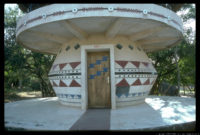
Today it is hard to imagine researchers being denounced for “aspostasy,” but many at Bujora were. They saved objects that missionaries had once forced the newly converted to burn. The government also viewed some of these objects as “backward” or even illegal.[28] Mudimbe believes that “African objects signify an “archival” dimension with a commemorative function. They impress onto their own society a silent discourse and, simultaneously, as loci of memory, recite silently their own past and that of the society that made them possible.”[29] The objects in the Sukuma Museum are “archival,” continue their “commemorative function[‘s]” and recite the changes they have experienced since Catholicism came to Bujora. The Sukuma Museum is a living museum and a cultural center. It supports a dance troupe, allows the objects in its care to be used in their intended function, and tells a tale of the Catholic Church and most of all Sukuma culture. In doing this the Museum hopes that it can avoid the outside influences that Trin Minh-Ha suggests can “work toward your erasure while urging you to keep your way of life and ethnic values.”[30] To be in control, to project identity, the Sukuma Museum plans to reveal its original agenda and the history the institution experienced in order to offer the visitor the option to gaze at the collection on multiple levels. The Museum is fighting the suffocation and decontextualization of ethnographic museums by offering the permanent collection the opportunity to tell its own history through the display as much as during contemporary dance competitions and royal ceremonies.
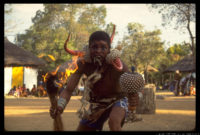
As a museum with limited financial support and professional training, the Sukuma Museum is fighting to sustain its commitment to Sukuma culture. Though the Museum’s mission may be very different from other museums mentioned in this text, the positive and negative issues raised by other museum experiences helped set the parameters of the project to register the collection and redesign the exhibition spaces. During the work, the Museum kept returning to the issues of history, context, and identity. The Museum realized that the use of its objects and those of the local community for rites and rituals which have descended from the Sukuma culture empowers the identity and symbolism of the objects in the Museum’s care. In many ways the object’s identity is related to history and changing contexts. When an object’s history and traditions are perpetuated, its identity is reinforced. Its use also exposes the identity while projecting history which places the objects within their original context. It is within this locus that traditional objects and ceremonies are renewed and revitalize by contemporary innovation and society. The Museum wants to be positioned at this site where tradition and innovation are melded because it is the meeting place of history, context, and identity.
1 Sukuma history and culture is still very much based on oral traditions. As the founders of the Museum were the first to institutionalize Sukuma history and culture, the history they chose to present through the museum display should be seen in the light of their agenda and as a construction of Sukuma history.
2 The work of such artists as Marcel Duchamp, Marcel Broadthers, Robert Smithson and Daniel Buren has influenced contemporary artists (such as Louise Lawler, Fred Wilson, and Carrie Mae Weems) and informed the criticism of museum practices concerning collecting and display.
3 If possible this would include relevant photography and video.
4 The objects exhibited by MoMA were partially overshadowed by the criticism of the art community and the missed opportunity of working with such a powerful collection to discuss critical issues concerning contextualization and early modernist appropriation. In terms of taxonomies, the shift of exhibition venues from a ethnographic museum to a modern or “high” art museum was substantial as it expanded the reach of African art.
5 James Clifford,The Predicament of Culture (Cambridge,1988), p. 12. He also posited the question, “How have exotic objects been given value as ‘art’ and ‘culture’ in western collecting systems?”
6 While many people may have been offended by the exhibition’s presentation, there is little doubt that the show increased the public’s awareness of African art.
7 Clifford, Predicament, page 96. In this context the use of the term “cultural imperialism” relates to the placement of African art/artifacts in a western museum setting with its own system of ordering without acknowledging the important historical taxonomic shift within western museums of viewing African works as “high” art. And by placing these objects in a context of “high” art, a western category, museums may neglect any sense of original cultural context or significance as in the London’s Royal Academy of the Arts exhibition, “Africa: The Art of a Continent.” Clifford writes that this shift requires a “critical historical discussion, not celebration.”
8 The Bana Cecilia, named after Cecilia the Catholic patron saint of music, was founded by Bishop Joseph Blomjous and Father Clement in 1954. The Bujora Research Committee was an offshoot of Bana Cecilia members who concentrated on cultural research of the Sukuma people. The Bana Cecilia was involved in every aspect of the founding of the Museum including the donation of all objects to the first exhibition building. Today, the Museum is mostly secular and administered by Tanzanians who hold the highest reverence for the work of Father Clement who died in 1986. The name Cecilia is translated into Kisukuma and Kiswhaili as Sesilia.
9 Members of the Dartington Hall Trust visited Bujora and were so impressed by the idea of a Sukuma museum that they donated funds to build the Royal Pavilion and later helped support the building of the Bagika and Bagalu Dance Pavilion. It seems that Father Clement was heavily influenced by the idea of a living museum from Dartington Hall.
10 This often lead to the isolation of Father Clement who in the early sixties was briefly banished from Bujora to the more isolated parish of Kahangara to slow his radical ideas and practices.
11 Under colonial rule many Sukuma royal families converted to Christianity, were educated in special schools and were willing to donate their royal regalia to a museum administered by the Church. Royal families and their regalia were also viewed with suspicion as the leaders were perceived by many to have been colonial administrators of the British and few had given voice or strong support to the Independence movement.
12 Interview with Mzee Zeferini Nkamba, April 10, 1995 in Ng’wangika village. Mzee Nkamba was a founding member of Bana Sesilia in 1954 and a member of the Research committee.
As the early missionaries to Africa believed that if they converted the Bugandan empire other Africans would follow and convert, Clement may have felt that if he could convert the leaders of Bagika and Bagalu, the two largest and most important dance societies in Usukuma, their followers would also convert. After meeting Mutessa I in 1875 Stanley wrote to Queen Victoria requesting for missionaries. He thought, that through Mutessa, Central Africa could be Christianized. The first Catholic missionaries, the Missionaries of Africa, led an expedition to Uganda across Lake Victoria from Kayenze in Usukuma to convert the royal families of the Bugandans. The first Catholic martyr was killed in 1885. This influenced their strategy for conversion in East Africa through the Bugandan empire.
13 The one week annual Bulabo dance festival continues today and is supported by the Sukuma Museum which administers the event with the elders of the Bagika and Bagalu Dance societies.
14 V.Y. Mudimbe, The Idea of Africa (Bloomington and Indianapolis, 1994), p.xv.
15 It is important to recognize, as Mudimbe does in the quote, that this taxonomic trap has also effected African scholars and thus museums in Africa.
16 When people converted to Christianity, they were forced to renounce the objects of their previous religion and beliefs and give them to the church. Some of these objects may have eventually entered into the collection of the museum.
17 Craig Owens, Beyond Recognition, Representation, Power, and Culture, (Berkeley,1992), p. 75.
For examples the exhibitions: Boston Museum of Fine Art’s exhibition “The Label Show, Contemporary Art and the Museum,” 1994 and The Metropolitan Museum of Art’s exhibition “Rembrandt/Not Rembrandt” in the Metropolitan Museum of Art: Aspects of Connoisseurship, 1995.
18 Mudimbe, The Idea Of Africa, p. 67.
19 ibid.
20 Tom Phillips, curator of the exhibition, quoted in “Out of Africa” written by Steven Vincent, Art & Auction, May 1996, p.123. The presupposition of this curatorial construction of “equality” can be interpreted as patronizing even though the curator’s intent may be otherwise.
21 Roy Sieber, Professor Emeritus of art history at Indiana University,quoted in “Out of Africa” written by Steven Vincent, Art & Auction, May 1996, p.123. As in the “Primitivism” exhibition at MoMA, the curatorial responsibilities of the Royal Academy show were handled by people not trained as African art historians. It was curated by Tom Phillips, a collector of African art, who defined himself as an “amateur in the old-fashioned English sense.” (Art & Auction, May 1996, p. 126.) In today’s highly educated and competitive curatorial work force it is difficult to imagine a major Renaissance, Egyptian, or Modernist exhibition curated by someone without so-called “proper credentials” in the field. This then begs the question of why was the major African art exhibition of the decade not curated by an art historian of African art.
22 Interview with Dr. Paul Msemwa, Director of the Village Museum, August 29th, 1996, Dar es Salaam, Tanzania.
23 Dr. Paul Msemwa, August 29th, 1996.
24 Dr. Paul Msemwa, August 29th, 1996.
25 Many visitors are Tanzanian primary and secondary school students.
26 There are many different types of Sukuma medicine in the collection. These include medicines for protection, to attract people, to dance well, for good luck and for healing, among other uses.
27 David Clement, “The research Committee at Bujora,” Tanganyka Notes and Records, No.81-82, 1977: 75-78.
28 Mzee Bulungute’ the leader of the Bagalu Dance Society in an interview on June 10, 1995, in Ng’wabochuma village, explained that in the recent past, the Tanzanian government did not appreciate cultural objects, but that today he can publicly display the Kafula. The Kafula is one of the most famous power objects in Usukuma.
29 Mudimbe, The Idea of Africa, p.68.
30 Trin Minh-Ha quoted in Michelle Wallace’s “Reading 1968 and the Great American Whitewash, in Barbara Kruger and Phil Mariani’s Remaking History (Seattle, 1989), p. 102.
